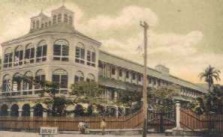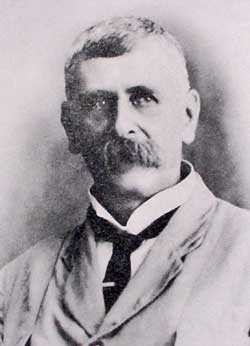
Georgetown is the capital and largest city of Guyana. It is situated in Demerara-Mahaica, region 4, on the Atlantic Ocean coast, at the mouth of the Demerara River. It is nicknamed the "Garden City of the Caribbean." It is the retail, administrative, and financial services centre of the country, and the city accounts for a large portion of Guyana's GDP. The city recorded a population of 118,363 in the 2012 census.
The history of Guyana begins about 35,000 years ago with the arrival of humans coming from Eurasia. These migrants became the Carib and Arawak tribes, who met Alonso de Ojeda's first expedition from Spain in 1499 at the Essequibo River. In the ensuing colonial era, Guyana's government was defined by the successive policies of the French, Dutch, and British settlers. During the colonial period, Guyana's economy was focused on plantation agriculture, which initially depended on slave labor. Guyana saw major slave rebellions in 1763 and 1823. Following the Slavery Abolition Act of 1833, 800,000 enslaved Africans in the Caribbean and South Africa were freed, resulting in plantations contracting indentured workers, mainly from India. Eventually, these Indians joined forces with Afro-Guyanese descendants of slaves to demand equal rights in government and society. After the Second World War, the British Empire pursued policy decolonization of its overseas territories, with independence granted to British Guiana on May 26, 1966. Following independence, Forbes Burnham rose to power, quickly becoming an authoritarian leader, pledging to bring socialism to Guyana. His power began to weaken following international attention brought to Guyana in wake of the Jonestown mass murder suicide in 1978.

British Guiana was a British colony, part of the mainland British West Indies, which resides on the northern coast of South America. Since 1966 it has been known as the independent nation of Guyana.
The Railways of Guyana comprised two public railways, the Demerara-Berbice Railway and the Demerara-Essequibo Railway. There are also several industrial railways mainly for the bauxite industry. The Demerara-Berbice Railway is the oldest in South America. None of the railways are in operation in the 21st century.

Georgetown City Hall is a nineteenth-century Gothic Revival building located on the corner of Regent Street and Avenue of the Republic in Georgetown, Guyana. The building was designed by architect Reverend Ignatius Scoles in 1887, and was completed in June 1889. The building houses the offices of the Mayor, the City Council, and the City Engineer.
Jan Lowe Shinebourne, also published as Janice Shinebourne, is a Guyanese novelist who now lives in England. In a unique position to be able to provide an insight into multicultural Caribbean culture, Shinebourne's is a rare and distinctive voice : She grew up on a colonial sugar plantation and was deeply affected by the dramatic changes her country went through in its transition from a colony to independence. She wrote her early novels to record this experience.

Guyana National Museum is a museum in Georgetown, Demerara-Mahaica, Guyana. It was established on 13 February 1868. The idea of starting a museum was conceived by members of the Royal Agricultural and Commercial Society (RACS) of British Guiana. When RACS was established in 1844, one of its aims was to construct a Museum to house local minerals, soils, timbers, fruits, seeds, gums, resins, dyes and drugs, as well as the flora and fauna of the country. British explorer Robert Schomburgk, the German botanist Carl Ferdinand Appun, Mr Bratt, and W.H. Campbell presented gifts to the RACS in order to start a Museum Collection. A fire in 1864 destroyed the donated collections.

New Amsterdam Public Hospital in New Amsterdam, Guyana, is the country's biggest hospital after Georgetown Public Hospital. It's old building is one of the two surviving buildings designed by Cesar Castellani, an architect employed in the Public Works Department of British Guiana.

Walter Edmund Roth was a British colonial administrator, anthropologist and medical practitioner, who worked in Queensland, Australia and British Guiana between 1898 and 1928.
Chindian (Hindi: चीनी-भारतीय; Chinese: 中印人; pinyin: Zhōngyìnrén; Cantonese Yale: Jūngyanyàn; Tamil: சிந்தியன்; Telugu: చిండియన్స్; is an informal term used to refer to a person of mixed Chinese and Indian ancestry; i.e. from any of the host of ethnic groups native to modern China and India. There are a considerable number of Chindians in Malaysia and Singapore. In Maritime Southeast Asia, people of Chinese and Indian origin immigrated in large numbers during the 19th and 20th centuries. There are also a sizeable number living in Hong Kong and smaller numbers in other countries with large overseas Chinese and Indian diaspora, such as Jamaica, Trinidad and Tobago, Suriname and Guyana in the Caribbean, as well as in Indonesia, the Philippines, the United States, Canada, United Kingdom, Australia, and New Zealand.

Quamina Gladstone, most often referred to simply as Quamina, was a Guyanese slave from Africa and father of Jack Gladstone. He and his son were involved in the Demerara rebellion of 1823, one of the largest slave revolts in the British colonies before slavery was abolished.
The first numbers of Chinese arrived in British Guiana in 1853, forming an important minority of the indentured workforce. After their indenture, many who stayed on in Guyana came to be known as successful retailers, with considerable integration with the local culture. The most notable person of Chinese ancestry was the Former Guyana President Arthur Chung, was independent Guyana's first President from 1970 to 1980, and the first Chinese head of state of a non-Asian country.

Sir Frederick Mitchell Hodgson, was a British colonial administrator who was Governor of the Gold Coast (1898–1900), Barbados (1900–04) and British Guiana (1904–11).

Alfred Athiel Thorne, LLD, MA, also known as A.A. Thorne, was a well-regarded elected statesman, author, pioneer for educational access, and human rights advocate in British Guyana. In 1894, Dr. Thorne founded and oversaw a co-educational private secondary school, providing educational access to students regardless of their gender, ethnicity, color, or socio-economic status. Called the "Hero of The People", Thorne served as a popularly-elected official for more than 50 years, working to unify the collective voices of working-class white British colonists, Indo-Guyanese, Afro-Guyanese, Chinese, Portuguese, and Aboriginal Amerindian communities across British Guyana. He served multiple elected and appointed roles at both the national and municipal levels, including as Mayor of British Guiana's capital city, Georgetown. Thorne served many decades as an educator, columnist writer, and elected official in British Guiana, having a lasting impact for generations by advocating for educational access, workplace safety, human rights, democracy, and self-determination.

General elections were held in British Guiana in 1916.

General elections were held in British Guiana in 1906.

James Rodway was a British-born historian, botanist and novelist of British Guiana. Considered British Guiana's premier historian, Rodway helped to establish national institutions such as the Royal Agricultural and Commercial Society of British Guiana and the British Guiana Museum. A Fellow of the Linnean Society, in later years he served as Editor of the colony's literary and scientific journal, Timehri.

Plantation Peter's Hall was a plantation on the east bank of the River Demerara in Dutch Guiana and British Guiana. It was probably laid out in the mid-eighteenth century and by the early nineteenth century had over 200 slaves before that institution was abolished in the British Empire.
Werk-en-rust, also Werken-Rust, is a ward in Georgetown, Guyana, located along the Demerara River that feeds into the Atlantic Ocean.
Guyanese nationality law is regulated by the 1980 Constitution of Guyana, as amended; the Citizenship Act of 1967, and its revisions; and various British Nationality laws. These laws determine who is, or is eligible to be, a national of Guyana. Guyanese nationality is typically obtained either on the principle of jus soli, i.e. by birth in Guyana; or under the rules of jus sanguinis, i.e. by birth abroad to parents with Guyanese nationality. It can also be granted to persons with an affiliation to the country, or to a permanent resident who has lived in the country for a given period of time through naturalisation. There is not currently a program in Guyana for persons to acquire nationality through investment in the country. Nationality establishes one's international identity as a member of a sovereign nation. Though it is not synonymous with citizenship, for rights granted under domestic law for domestic purposes, the United Kingdom, and thus the Commonwealth, have traditionally used the words interchangeably.













